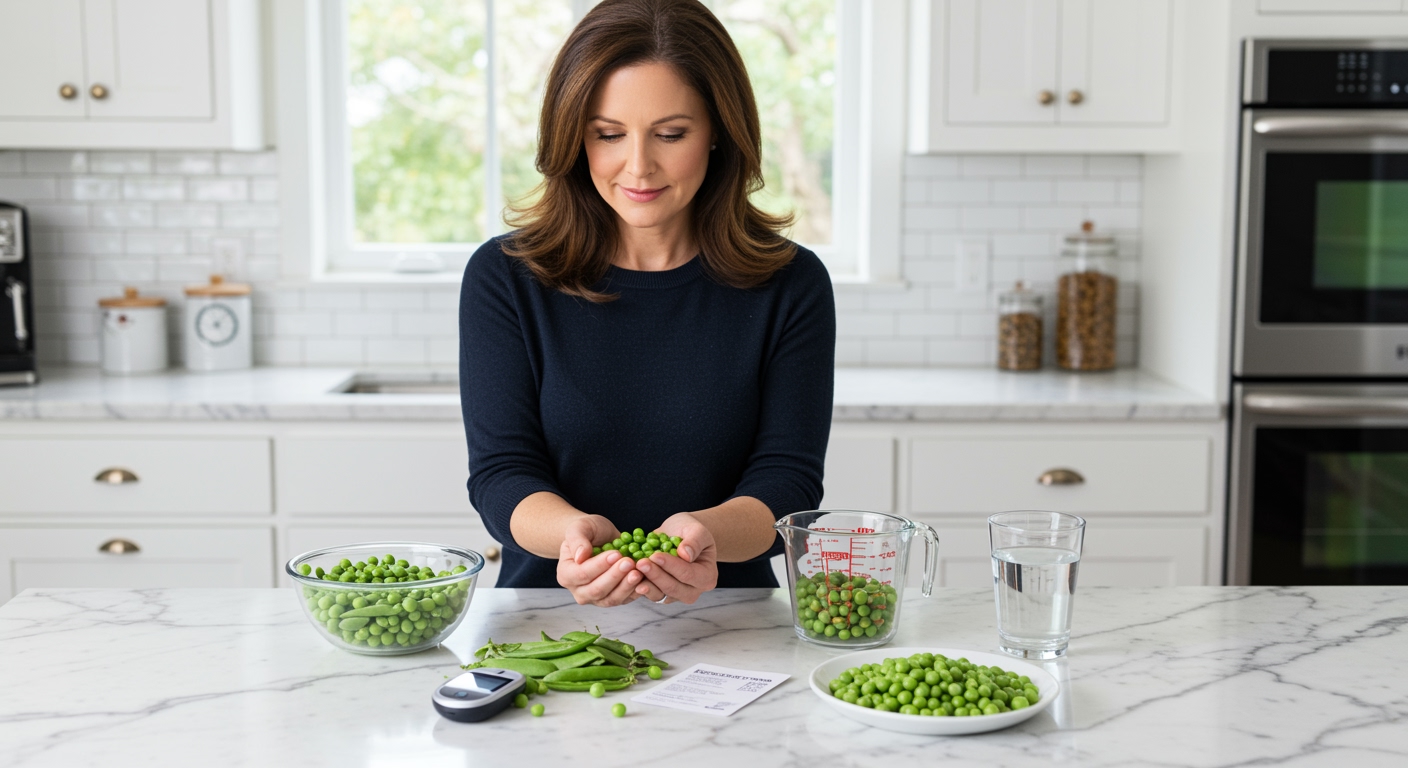✪ Key Takeaway: Green peas are safe for diabetes when eaten in controlled portions due to their moderate glycemic index of 48-54.
Introduction
You stare at that bowl of green peas and wonder if they will spike your blood sugar.
Many people with diabetes feel confused about which vegetables are truly safe because some contain more carbs than others.
Hi, I am Abdur, your nutrition coach and today I am going to explain exactly how green peas affect your blood sugar and whether they belong in your diabetes meal plan.
What Makes Green Peas Different From Other Vegetables?
Green peas stand apart from most vegetables because they contain higher carbohydrate content than leafy greens or cruciferous vegetables.
One cup of cooked green peas provides about 25 grams of carbohydrates compared to just 5 grams in a cup of broccoli.
However, these carbs come packaged with 8 grams of fiber and 8 grams of protein, which significantly changes how your body processes them.
The fiber in green peas slows down digestion and helps prevent rapid blood sugar spikes that diabetics need to avoid.
This combination of nutrients makes green peas a complex carbohydrate source rather than a simple sugar that would cause immediate blood glucose elevation.
Research shows that the protein and fiber work together to create a more gradual release of glucose into your bloodstream.
✪ Fact: Green peas contain both soluble and insoluble fiber, with soluble fiber being particularly beneficial for blood sugar control.
How Do Green Peas Affect Your Blood Sugar Levels?
Green peas have a moderate glycemic index of 48-54, which places them in the medium range for blood sugar impact.
This means they will raise your blood glucose more slowly than white bread or potatoes but faster than non-starchy vegetables like spinach.
The glycemic load of a half-cup serving is approximately 4, which is considered low and manageable for most people with diabetes.
Your blood sugar response will depend on several factors including portion size, what you eat with the peas, and your individual insulin sensitivity.
Studies indicate that eating green peas with protein or healthy fats further reduces their glycemic impact by slowing carbohydrate absorption.
The resistant starch in green peas also feeds beneficial gut bacteria, which may improve insulin sensitivity over time.
Most diabetics can include green peas in their meals without significant blood sugar spikes when consumed in appropriate portions.
✪ Pro Tip: Test your blood sugar 2 hours after eating green peas to understand your personal response.
What Are The Best Ways To Include Green Peas In Your Diabetes Diet?
Portion control remains the most important factor when adding green peas to your diabetes meal plan.
A safe serving size is typically half a cup of cooked green peas, which provides about 12-13 grams of carbohydrates.
Pair green peas with lean proteins like grilled chicken, fish, or tofu to create balanced meals that minimize blood sugar fluctuations.
Adding healthy fats such as olive oil or nuts to dishes containing green peas helps slow carbohydrate absorption even further.
Fresh or frozen green peas are better choices than canned varieties, which often contain added sugars or sodium that can affect blood pressure.
Cooking methods matter too – steaming or lightly sautéing preserves more nutrients than boiling, which can leach out water-soluble vitamins.
Consider eating green peas earlier in the day when your insulin sensitivity is typically higher and your body can better handle the carbohydrate load.
✪ Note: Frozen green peas often retain more nutrients than fresh ones that have been stored for extended periods.
Are There Any Risks Of Eating Green Peas With Diabetes?
The main risk comes from overconsumption rather than the green peas themselves being harmful to diabetics.
Eating large portions can lead to blood sugar spikes, especially if you consume them without balancing proteins or fats.
Some people with diabetes may experience digestive discomfort from the high fiber content if they increase their intake too quickly.
Green peas contain natural sugars including sucrose and fructose, which contribute to their total carbohydrate count.
People taking certain diabetes medications should monitor their blood sugar more closely when adding new foods like green peas to avoid unexpected fluctuations.
Processed pea products like pea flour or pea protein powder may have different effects on blood sugar than whole green peas.
Always count green peas as part of your total carbohydrate intake for the meal rather than treating them as a free food like non-starchy vegetables.
✪ Pro Tip: Keep a food diary to track how different portions of green peas affect your individual blood sugar patterns.
The Bottom Line
Green peas can be a nutritious addition to your diabetes diet when consumed in appropriate portions and combined with other balanced nutrients.
Smart eating is not about avoiding foods completely but learning how to include them wisely in your overall health plan.
I would love to hear about your experience with green peas and diabetes management, so please share your thoughts or questions in the comments below.
References
At NutritionCrown, we use quality and credible sources to ensure our content is accurate and trustworthy. Below are the sources referenced in creating this article:
- SugarFit: Green Peas for Diabetes
- Fitterfly: Are Peas Good for Diabetes
- January AI: Green Peas Glycemic Index
- UKRI: Pea Starch Findings Could Help Prevent Diabetes





